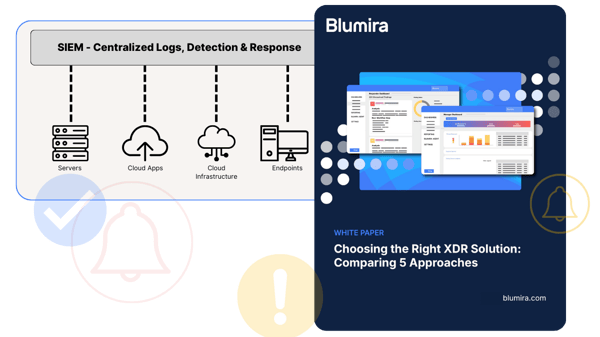- Product
Product Overview
Sophisticated security with unmatched simplicityCloud SIEM
Pre-configured detections across your environmentHoneypots
Deception technology to detect lateral movementEndpoint Visibility
Real-time monitoring with added detection & responseSecurity Reports
Data visualizations, compliance reports, and executive summariesAutomated Response
Detect, prioritize, and neutralize threats around the clockIntegrations
Cloud, on-prem, and open API connectionsXDR Platform
A complete view to identify risk, and things operational
- Pricing
- Why Blumira
Why Blumira
The Security Operations platform IT teams loveWatch A Demo
See Blumira in action and how it builds operational resilienceUse Cases
A unified security solution for every challengePricing
Unlimited data and predictable pricing structureCompany
Our human-centered approach to cybersecurityCompare Blumira
Find out how Blumira stacks up to similar security toolsIntegrations
Cloud, on-prem, and open API connectionsCustomer Stories
Learn how others like you found success with Blumira
- Solutions
- Partners
- Resources
Extended Detection and Response
XDR Solution for SMBs
Blumira’s XDR features helps SMBs detect and respond to threats faster by analyzing all security data in one place, free of complexity and high costs.
Demystify your digital defenses and stay a step ahead with SOC Auto-Focus — making every member of your team an effective responder.
What Sets Our XDR Features Apart?
Discover the unique blend of simplicity, power, and adaptability that elevates our XDR security platform above the rest.
Comprehensive Alerts
Ease of Use
Seamless Integrations
Consolidation
Managed Solution
Easy, Effective Security Stack
We deliver enhanced cybersecurity with our suite of protection without requiring in-house resources.
-
Managed SIEM
Start With Cloud Workload SIEM
Free up your team’s time with Blumira’s cloud SIEM, with detection rules managed by our security engineers and supported by our security engineers.
- Easy integration setup,
- pre-tuned to filter noisy alerts,
- one year of data retention to meet compliance,
- and reporting insights and visualizations for threat intelligence.
-
Endpoint Monitoring
Layer in Endpoint Visibility
Deploy Blumira Agent in minutes to get security insight into Windows, MAC, and Linux endpoints located anywhere – this lightweight endpoint agent requires no additional infrastructure to work.
Easy to deploy in minutes, Blumira Agent, is tailored for real-time threat detection and mitigation.
-
Security Automation
Add Automated Response
Block threats immediately -- Blumira Agent automatically isolates an endpoint from your network when a critical threat is identified and blocks traffic from known malicious IP addresses with Automated Blocking (for Dynamic Blocklists).
SOC Auto-Focus accelerates your security investigations by analyzing evidence from new findings and presenting it in plain language, along with a breakdown of its risk potential.
-
Honeypots
Honeypots
Trap threat actors looking to make lateral movements. Blumira enables you to effortlessly deploy and manage decoy data, or honeypots. -
Playbooks
Playbooks
To streamline the threat detection and response process, Blumira’s security team has designed pre-defined procedures that guide your team through remediation and response – no need for security expertise. They make it simple for you with one click. -
SecOps Support
Security Operations Center (SOC) SecOps Support
24/7 SecOps support for critical alerts means you're never alone. Our experts are here to bring you customized support that solves your problems.
Start With Cloud Workload SIEM
Free up your team’s time with Blumira’s cloud SIEM, with detection rules managed by our security engineers and supported by our security engineers.
- Easy integration setup,
- pre-tuned to filter noisy alerts,
- one year of data retention to meet compliance,
- and reporting insights and visualizations for threat intelligence.
Layer in Endpoint Visibility
Deploy Blumira Agent in minutes to get security insight into Windows, MAC, and Linux endpoints located anywhere – this lightweight endpoint agent requires no additional infrastructure to work.
Easy to deploy in minutes, Blumira Agent, is tailored for real-time threat detection and mitigation.
Add Automated Response
Block threats immediately -- Blumira Agent automatically isolates an endpoint from your network when a critical threat is identified and blocks traffic from known malicious IP addresses with Automated Blocking (for Dynamic Blocklists).
SOC Auto-Focus accelerates your security investigations by analyzing evidence from new findings and presenting it in plain language, along with a breakdown of its risk potential.
Honeypots
Trap threat actors looking to make lateral movements. Blumira enables you to effortlessly deploy and manage decoy data, or honeypots.Playbooks
To streamline the threat detection and response process, Blumira’s security team has designed pre-defined procedures that guide your team through remediation and response – no need for security expertise. They make it simple for you with one click.Security Operations Center (SOC) SecOps Support
24/7 SecOps support for critical alerts means you're never alone. Our experts are here to bring you customized support that solves your problems.The Product You Need. The Support You Deserve
15
min/day
on average to manage Blumira and respond to threats
99.4
%
faster average detection time vs industry average
24
/7
automated monitoring
99.7
%
CSAT rating for our support teams

Supercharge Your Defense with an XDR Solution
Dive into our whitepaper to explore how XDR features can revolutionizes your cybersecurity strategy. We unlock behavioral analytics, superior detection, seamless investigations, and unmatched rapid response. Empower your organization with the knowledge to outsmart threats and safeguard your digital landscape.
Read the WhitepaperIn Their Own Words
Hear directly from our partners and customers about how Blumira has transformed their cybersecurity posture.
“I told my director it’s like adding another employee, except much cheaper. That was a major driver — that Blumira was going to be taking care of the solution.”
Les Neely
System Admin, Upward Sports
“Being able to send logs from clients, servers, network equipment and cloud sources is very important. Knowing what is going on at all times and being alerted to something occurring allows us to look into who did what, when, and respond very quickly.”
Khan H.
Network Engineer, Mid-Market Transportation Company
“Blumira reduces the number of security staff required to monitor firewall, antivirus, shared drives, infrastructure configs and overall change management. We're alerted to only the important/critical alerts and there are actually useful information guides to walk you through resolutions.”
System Administrator
Mid-Marketing Education Management Company
Read up on the Latest Insights
View More
Security How-To
4 min read
| September 4, 2025
Cybersecurity Training in Manufacturing: Insights from the 2025 Verizon Data Breach Investigations Report
Read More
SIEM XDR
7 min read
| June 9, 2025
Customer Story: NetCenter Technologies
Read More
Compliance Security Frameworks and Insurance
7 min read
| May 26, 2025
Customer Story: United Way of Pierce County
Read MoreTry Blumira Free For 30 Days
Blumira combines crystal-clear threat detection with response capabilities that don't require a security PhD. Think automated blocking, one-click isolation, and explanations that actually explain.